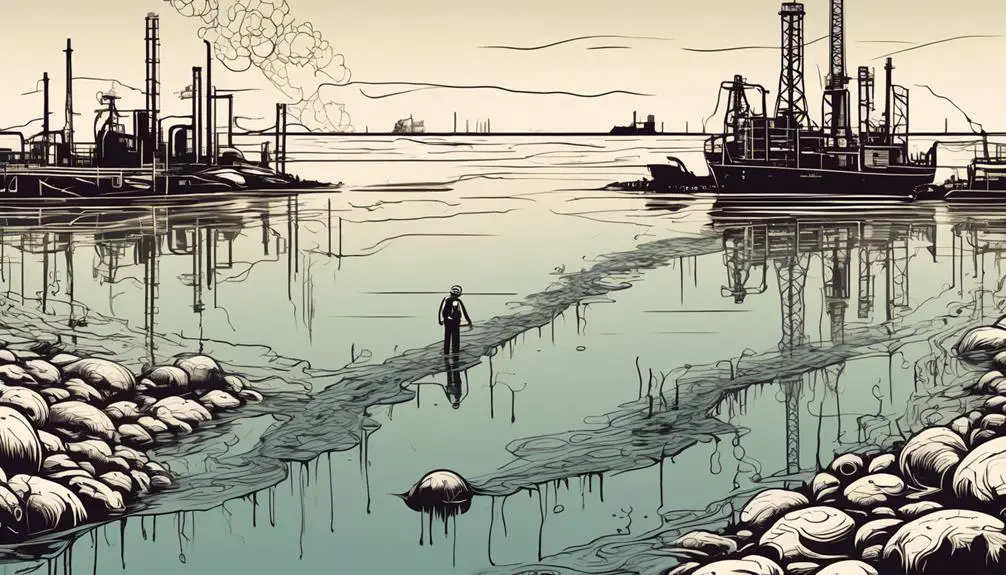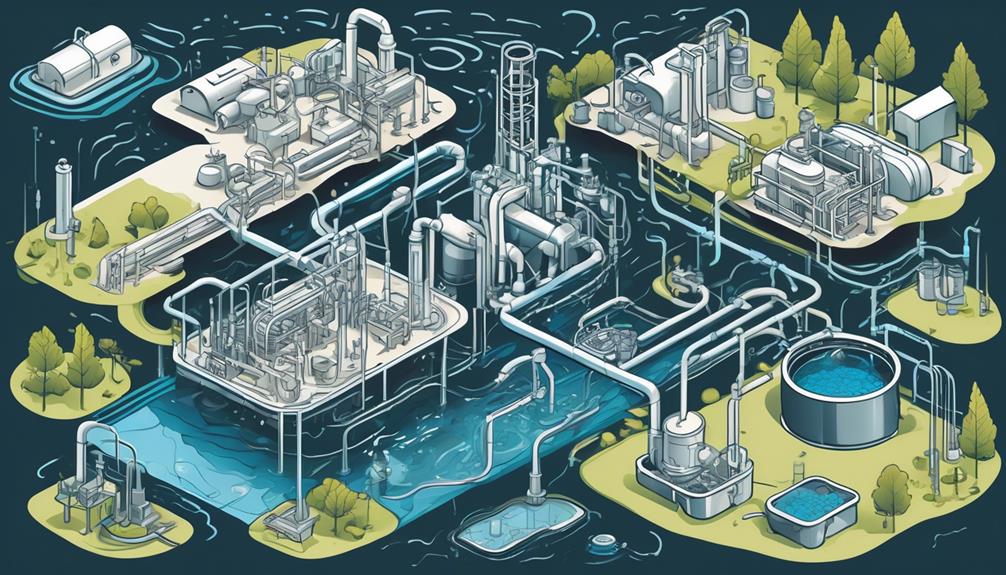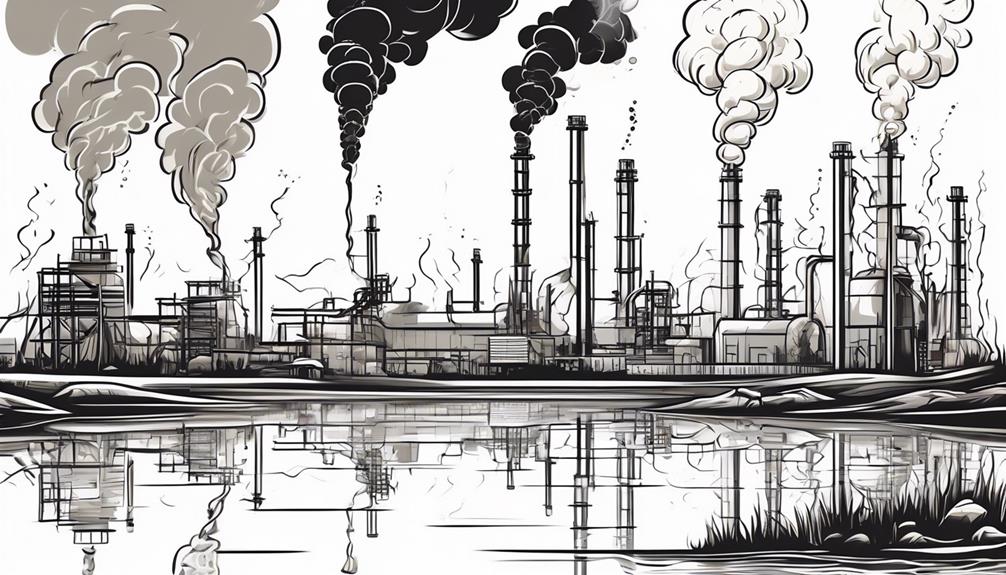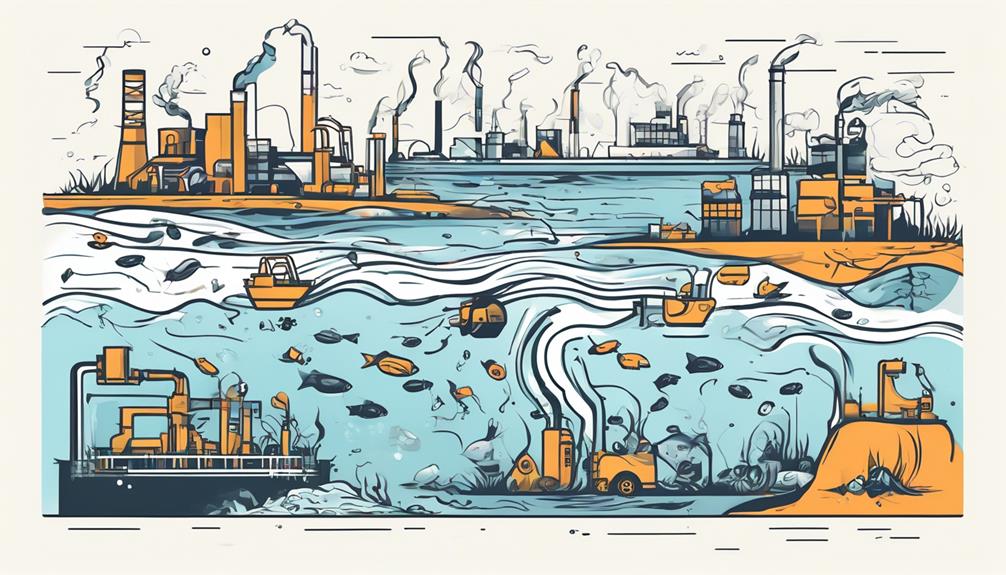Hey there, ever wondered about the impact industries have on water pollution? Well, get ready to dive into the 10 best explanations that shed light on this issue.
From industrial waste disposal practices to the contribution of the oil and gas industry, each explanation offers a unique perspective on how different industries influence water contamination.
But that's not all, we'll also explore the effects of agricultural runoff, heavy metal contamination, and industrial emissions on our precious water bodies.
And don't worry, we won't leave you hanging – we'll discuss efforts to regulate and mitigate industrial water pollution, ensuring you have a complete understanding of the topic.
So, let's jump right in and uncover the secrets behind industries' influence on water pollution.
Key Takeaways
- Improper waste disposal by various industries, including chemical plants, fertilizer plants, and inorganic chemical plants, contributes to water pollution.
- Mining activities release heavy metals, contaminants, and acid mine drainage into water sources, leading to significant water pollution.
- The introduction of pollutants from industrial and mining activities harms aquatic ecosystems, making water resources unsuitable for drinking, agriculture, and supporting aquatic life.
- Implementing effective wastewater treatment systems, adopting sustainable mining practices, regular monitoring and testing of water sources, and updating regulations are crucial steps towards mitigating water pollution caused by industries.
Industrial Waste Disposal Practices
Industrial waste disposal practices contribute significantly to water pollution, posing a threat to our waterways and ecosystems. Various industrial activities, such as oil refineries, chemical plants, and fertilizer plants, play a major role in the release of toxic pollution into our waters.
Outdated regulations from the Environmental Protection Agency (EPA) are partly to blame for this problem. These regulations fail to adequately address the environmental and health consequences of industrial waste disposal. As a result, corporations have been allowed to continue polluting under standards that don't prioritize the protection of our water resources.
To combat this issue, stronger regulations are necessary to eliminate industrial pollutants and protect our waterways. Efforts have been made to address this problem, including lawsuits against the EPA and support from allies who recognize the importance of clean water and our overall well-being.
It is crucial that we prioritize the proper disposal of industrial waste to prevent further damage to our water ecosystems. By holding industries accountable and implementing stricter regulations, we can work towards reducing the toxic pollution that threatens our waterways and the life they support.
Chemical Pollutants From Manufacturing Processes
Chemical pollutants released during manufacturing processes significantly contribute to water pollution, posing a grave threat to our waterways and ecosystems. The manufacturing industry, including sectors such as oil and gas, is a major source of toxic chemicals that find their way into our water sources.
Here are three key points to understand about chemical pollutants from manufacturing processes:
- Chemical and plastic plants: These facilities release a wide range of pollutants into waterways. For example, benzene, a known carcinogen, can be released during the production of plastics. Lead, another harmful substance, can also contaminate water sources from manufacturing processes.
- Fertilizer plants: These plants play a role in agricultural production, but their activities can have detrimental effects on water bodies. They often dump nitrogen, cyanide, and other chemicals into water, leading to water pollution and ecological damage.
- Inorganic chemical plants: These manufacturing facilities contribute to toxic pollution in water sources. They may release various hazardous substances, including heavy metals, acids, and solvents. Once these toxic chemicals enter waterways, they can harm aquatic life and pose risks to human health.
It is crucial for manufacturing industries to adopt more sustainable practices and employ stricter regulations to minimize the release of chemical pollutants. By doing so, we can protect our water resources and ensure the well-being of our ecosystems.
Impact of Mining Activities on Water Quality
Mining activities have a significant impact on water quality. Heavy metals and other contaminants are released into water sources, leading to pollution. This contamination can harm aquatic ecosystems and pose risks to human health.
It's crucial to address mining's water contamination, understand its effects on aquatic ecosystems, and implement effective remediation and prevention measures to protect our water resources.
Mining's Water Contamination
The impact of mining activities on water quality is evident through the contamination caused by the release of heavy metals and toxic chemicals. Here are three key ways in which mining can contribute to water pollution:
- Acid mine drainage: Mining activities can result in the release of acidic water containing metals and sulfates. This phenomenon, known as acid mine drainage, can cause significant water pollution, harming aquatic life and ecosystems.
- Leaching of toxic substances: Surface and groundwater can be contaminated by the leaching of toxic substances from mining waste and tailings. These substances can include heavy metals, such as lead and mercury, as well as other hazardous chemicals, posing risks to human health and the environment.
- Disturbance of natural water flow: Mining activities can disturb the natural flow of water, leading to sedimentation and siltation. This can have detrimental effects on aquatic ecosystems, reducing water quality and impacting the organisms that rely on these habitats.
Mining's water contamination is a serious issue that requires careful management and regulation to prevent further pollution and protect our water resources.
Effects on Aquatic Ecosystems
Pollutants introduced by mining activities pose a significant threat to the delicate balance of aquatic ecosystems. Mining activities can introduce heavy metals, oils, and greases into waterways, harming aquatic ecosystems. Chemical and plastic plants release pollutants like benzene and lead, which affect water quality and aquatic life. Fertilizer plants dump nitrogen, cyanide, and other chemicals into water, impacting aquatic ecosystems. Inorganic chemical plants contribute to toxic pollution, severely affecting water quality and aquatic organisms. The contamination of water resources due to mining activities makes them unsuitable for drinking, agriculture, and supporting aquatic life. To better understand the impact of mining on water quality, let's take a look at the table below:
| Mining Activities | Pollutants Released | Impact on Aquatic Ecosystems |
|---|---|---|
| Heavy metals | Mercury, lead | Poisoning of aquatic life |
| Oils and greases | Hydrocarbons | Smothering of aquatic organisms |
| Benzene and lead | Chemical plants | Water toxicity |
| Nitrogen, cyanide | Fertilizer plants | Algae blooms, oxygen depletion |
| Inorganic chemicals | Toxic chemicals | Damage to fish and aquatic plants |
As you can see, the impact of mining activities on water quality is extensive and detrimental to aquatic ecosystems. It is crucial for industries to implement proper measures to prevent and mitigate water pollution caused by mining.
Remediation and Prevention
To address the impact of mining activities on water quality, it's crucial for industries to take proactive measures for remediation and prevention. Here are three important steps that can be taken to mitigate the effects of mining on water pollution:
- Implementing effective wastewater treatment systems: Industries must invest in advanced treatment technologies to remove pollutants from their wastewater before it's discharged into water bodies. This will help minimize the contamination of water sources and reduce the risk of water pollution.
- Adopting sustainable mining practices: Industries should prioritize sustainable mining practices that minimize the release of harmful substances into the environment. This can include using less toxic chemicals, properly managing waste and tailings, and implementing measures to prevent leaks and spills.
- Monitoring and regular testing: Regular monitoring and testing of water quality is essential to identify potential sources of pollution and take corrective actions promptly. By implementing robust monitoring programs, industries can detect any deviations from acceptable water quality standards and address them before they cause significant harm.
Oil and Gas Industry's Contribution to Water Pollution

Did you know that the oil and gas industry has a significant impact on water pollution? Through chemical discharges, spills, and leakages, this industry releases heavy metals, oils, greases, and hazardous substances into waterways.
These pollutants not only harm the environment but also disproportionately affect low-income communities and communities of color.
It's important to understand the consequences of the oil and gas industry's actions and advocate for stricter regulations to protect our water resources.
Chemical Discharge Impact
The oil and gas industry's chemical discharge contributes significantly to water pollution, releasing heavy metals, oils, and other pollutants into our waterways. Here are three key impacts of chemical discharge from the oil and gas industry:
- Oil refineries are major contributors to water pollution. Discharge from these facilities includes heavy metals and oils, which can have devastating effects on aquatic ecosystems. These pollutants can contaminate water sources, leading to the destruction of marine life and the disruption of delicate ecosystems.
- Chemical and plastic plants also play a role in water pollution. These facilities release pollutants like benzene and lead, which are harmful to both human health and the environment. These toxic substances can accumulate in water bodies, posing a threat to aquatic organisms and potentially entering the food chain.
- Fertilizer plants discharge nitrogen, cyanide, and other chemicals into water sources. These chemicals can cause eutrophication, a process where excessive nutrients in the water lead to harmful algal blooms. These blooms deplete oxygen levels in the water, suffocating fish and other aquatic species. Additionally, inorganic chemical plants are also contributors to toxic pollution in water bodies, further exacerbating the problem.
Spills and Leakages
Spills and leakages from the oil and gas industry have a significant impact on water pollution. When accidents happen, harmful substances are released into our waterways, leading to serious consequences for both the environment and human health.
Oil refineries, for example, discharge heavy metals, oils, and greases into the water, while chemical and plastic plants release pollutants like benzene and lead. Fertilizer plants also contribute to the problem by dumping nitrogen, cyanide, and other chemicals.
These spills and leakages not only contaminate water sources but also disrupt the delicate balance of aquatic ecosystems. The result is the loss of biodiversity and the destruction of habitats.
It's crucial that we address these issues and implement stricter regulations to prevent such incidents and protect our water resources from further pollution.
Agricultural Runoff and Its Effects on Water Contamination
Agricultural practices contribute significantly to water contamination through the runoff of fertilizers and pesticides used in crop production. This runoff occurs when rainwater or irrigation water carries these chemicals from farmland into nearby bodies of water, such as rivers, lakes, and streams. The effects of agricultural runoff on water contamination are far-reaching and can have serious consequences for both the environment and human health.
- Nutrient pollution: Excessive use of fertilizers in agriculture leads to the release of nutrients, such as nitrogen and phosphorus, into water bodies. These nutrients promote the growth of harmful algal blooms, which deplete oxygen levels in the water and disrupt the aquatic ecosystem. This phenomenon, known as eutrophication, can result in fish kills and the loss of biodiversity.
- Pesticide contamination: Pesticides used to control pests and weeds in agriculture can also contaminate water sources through runoff. These chemicals can have toxic effects on aquatic organisms, including fish, amphibians, and invertebrates. Additionally, pesticide residues in water can pose a risk to human health if consumed through contaminated drinking water or the consumption of contaminated fish and shellfish.
- Soil erosion: Intensive agricultural practices, such as tilling and excessive irrigation, can lead to soil erosion. When soil erodes, it's carried away by runoff and deposited into water bodies. This sedimentation can impair water quality by clouding the water, reducing light penetration, and smothering aquatic habitats.
To mitigate the impacts of agricultural runoff on water contamination, best management practices, such as implementing buffer zones, reducing fertilizer and pesticide use, and adopting conservation tillage techniques, are essential. By implementing these measures, we can preserve water quality and protect the health of both ecosystems and communities.
Industrial Wastewater Treatment and Its Effectiveness

Industrial wastewater treatment plays a crucial role in reducing water pollution caused by harmful chemical compounds. By implementing treatment facilities, major industries can effectively remove pollutants from their wastewater before discharge.
However, smaller-scale industries may not have the same resources, resulting in untreated wastewater being released into water bodies. Therefore, it's important to assess the treatment efficiency rates, environmental impact, and regulatory compliance measures to ensure effective industrial wastewater treatment and minimize its negative effects on water quality.
Treatment Efficiency Rates
Treatment efficiency rates play a crucial role in assessing the effectiveness of industrial wastewater treatment processes. These rates measure the ability of treatment systems to remove pollutants from industrial wastewater.
Here are three key points to consider about treatment efficiency rates:
- Factors influencing treatment efficiency rates: The type of pollutants, treatment methods, and system design all impact these rates. Different pollutants require specific treatment processes, and the design of the treatment system can affect its overall efficiency.
- Importance of monitoring treatment efficiency rates: Regular assessment of these rates is vital for ensuring compliance with water quality standards. By monitoring and analyzing treatment efficiency rates, industries can identify areas for improvement and make necessary changes to reduce their impact on water pollution.
- Continuous improvement: To minimize the environmental impact of industrial wastewater, it's essential to strive for continuous improvement in treatment efficiency rates. By constantly evaluating and enhancing treatment processes, industries can effectively reduce water pollution caused by their operations.
Environmental Impact Assessment
As we shift our focus to the environmental impact assessment of industrial wastewater treatment and its effectiveness, it is important to understand the implications of treatment efficiency rates on water pollution. Industrial wastewater contains identifiable chemical compounds and proper treatment is crucial to prevent its harmful effects on water bodies. Let's take a closer look at the effectiveness of industrial wastewater treatment in reducing water pollution:
| Treatment Process | Description | Effectiveness |
|---|---|---|
| Physical Treatment | Involves the removal of suspended solids and contaminants through processes like sedimentation or filtration. | Moderate |
| Chemical Treatment | Uses chemicals to neutralize or remove pollutants through processes like coagulation or oxidation. | High |
| Biological Treatment | Utilizes microorganisms to break down organic matter in wastewater, reducing pollutants. | High |
These treatment processes play a vital role in reducing water pollution caused by industrial activities. However, it is important to continuously monitor and improve these processes to ensure their effectiveness in protecting our water resources.
Regulatory Compliance Measures
To effectively address water pollution caused by industrial activities, regulatory compliance measures must be implemented to ensure the effectiveness of wastewater treatment. The Environmental Protection Agency (EPA) plays a crucial role in setting and enforcing regulations under the Clean Water Act.
Here are three important points to consider:
- Outdated regulations: Industrial wastewater treatment regulations are outdated, which contributes to water pollution. Updating these regulations is necessary to eliminate pollution discharges from industries and protect water quality.
- Tightening regulations: By tightening regulations, the EPA can set updated limits on industrial pollutants. These updated limits could significantly reduce the amount of pollutants released by industries and help safeguard water quality.
- Accountability and community support: It's essential to hold the EPA accountable and prioritize clean water. Legal action can be taken to ensure compliance, and rallying community support can also help push for stricter regulations and more effective wastewater treatment.
Heavy Metal Contamination From Industrial Sources

Industrial sources contribute significantly to the contamination of water with heavy metals, posing a grave threat to water quality. Heavy metal pollution in waterways is primarily caused by industrial activities such as oil refineries, chemical and plastic plants, and fertilizer plants. These industries release toxic heavy metals like lead, mercury, cadmium, and arsenic into the environment through their waste disposal systems.
Outdated regulations and the Environmental Protection Agency's (EPA) failure to update limits on industrial water pollution exacerbate the problem. This lack of regulation allows industrial sources to continue releasing harmful heavy metals without consequence. As a result, water bodies become contaminated, leading to detrimental effects on both aquatic ecosystems and human health.
Furthermore, heavy metal contamination from industrial sources disproportionately affects low-income communities and communities of color. These vulnerable communities often bear the brunt of industrial pollution, as they're more likely to live near industrial facilities. This environmental injustice further highlights the urgent need for action.
To address this issue, it's crucial to hold the EPA accountable for enforcing stricter regulations on industrial water pollution. Additionally, advocating for the prioritization of clean water and supporting initiatives that promote sustainable industrial practices can help minimize heavy metal contamination from industrial sources. By taking these steps, we can work towards ensuring safer water resources for all.
Role of Industrial Emissions in Water Pollution
With heavy metal contamination from industrial sources posing a grave threat to water quality, it's crucial to examine the role of industrial emissions in water pollution. Industrial activities release various pollutants into our waterways, contributing to the degradation of water quality and harming aquatic ecosystems.
Here are three important points to consider regarding the role of industrial emissions in water pollution:
- Outdated regulations and neglect by the Environmental Protection Agency (EPA) play a significant role in allowing dirty industries to pollute our water. The lack of stringent limits on industrial water pollution allows harmful discharges to continue, posing a risk to both human health and the environment.
- Industries such as oil refineries, chemical and plastic plants, and fertilizer plants are major contributors to water pollution through their emissions. These emissions can contain toxic substances and pollutants that contaminate water sources, making them unsafe for consumption and detrimental to aquatic life.
- The disproportionate impacts of industrial water pollution on low-income and minority communities highlight the need for stronger regulations and accountability. Negligence by the EPA has allowed these communities to bear the brunt of the pollution, exacerbating existing environmental injustices.
To combat industrial emissions and protect water quality, it's crucial for communities to hold the EPA accountable through lawsuits and community support. By advocating for stricter regulations and enforcing clean water standards, we can ensure a healthier and sustainable future for all.
Industrial Contribution to Plastic Pollution in Water Bodies

Plastic pollution in water bodies is exacerbated by the contributions of various industries, releasing harmful pollutants and waste into aquatic ecosystems. Industrial activities play a significant role in the contamination of water bodies with plastics. Plastic plants and chemical industries are major contributors to plastic pollution, as they release pollutants like benzene, lead, and plastic waste into water bodies. These pollutants and waste can have detrimental effects on aquatic life and disrupt ecosystems.
To give you a clearer picture of the industrial contribution to plastic pollution, let's take a look at the following table:
| Industry | Contribution to Plastic Pollution |
|---|---|
| Plastic plants | Release plastic waste and microplastics into water bodies |
| Chemical industries | Discharge pollutants like benzene and lead into water bodies |
| Improper waste management | Results in plastic waste entering water bodies |
The discharge of industrial plastic waste into water bodies not only harms marine life but also poses a threat to human health. Microplastics, which are tiny plastic particles, can enter the food chain and accumulate in fish and other seafood that we consume.
To address this issue, it is crucial to tighten regulations and enforce proper waste management practices in industries. By implementing stricter measures, we can reduce the industrial contribution to plastic pollution in water bodies and protect our precious aquatic ecosystems.
Efforts to Regulate and Mitigate Industrial Water Pollution
Now let's shift our focus to the efforts being made to regulate and mitigate water pollution caused by various industries. It's crucial to take action against the toxic discharges from dirty industries like oil refineries, chemical plants, and fertilizer plants.
Here are three important efforts being made to address industrial water pollution:
- Tightening regulations: The Environmental Protection Agency (EPA) has neglected its duty to update decades-old regulations, allowing dirty industries to contribute to water pollution. Tightening regulations is necessary to eliminate pollution discharges and reduce industrial pollutants significantly. By holding industries accountable for their actions, we can strive for cleaner water.
- Protecting vulnerable communities: Low-income communities and communities of color are disproportionately affected by industrial water pollution. While the EPA allows corporations to continue polluting under outdated standards, it's crucial to fight for clean water for all. Efforts are being made to bring attention to this environmental injustice and garner support from allies to protect these communities.
- Taking legal action: To combat the EPA's negligence, filing lawsuits against polluting industries has become an important tool. By holding these industries accountable in court, we can push for stricter regulations and demand that they clean up their act. Legal action is a powerful way to protect our water resources and ensure a healthier future.
Frequently Asked Questions
How Do Industries Contribute to Water Pollution?
Industries contribute to water pollution by releasing harmful pollutants into waterways, impacting aquatic ecosystems. To mitigate this, measures such as strengthening regulations under the Clean Water Act can help reduce industrial waste and protect our water resources.
Which Industry Causes the Most Water Pollution?
The oil industry causes the most water pollution due to its discharge of heavy metals, oils, and greases. Environmental regulations need to be updated to enforce sustainable practices and protect our waterways.
How Do Factories Contribute to Water Pollution?
Factories contribute to water pollution by releasing heavy metals, oils, and toxins. These pollutants harm waterways and ecosystems. Outdated regulations and neglect by the EPA allow corporations to continue polluting, impacting both urbanization and agricultural practices.
Which Industry Contributes More to Water Pollution Than Any Other?
The industry that contributes more to water pollution than any other is the chemical industry. Their lack of compliance with environmental regulations has a significant impact on ecosystems and the overall quality of water.
Conclusion
So there you have it, folks. Industries play a major role in polluting our precious water resources. From agricultural runoff to chemical pollutants, their actions have far-reaching consequences.
It's high time we hold them accountable and demand stricter regulations. After all, it's like the saying goes, 'You can't have your cake and eat it too.' We can't allow industries to profit at the expense of our water quality.
It's time for action, and it starts with us.
